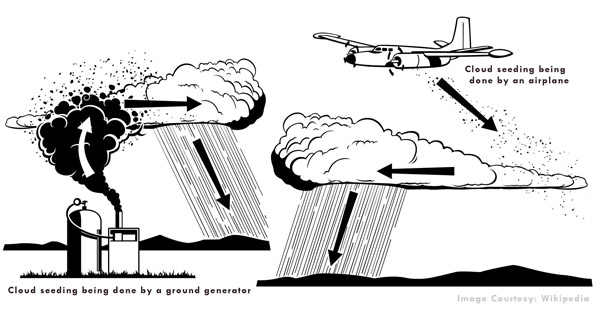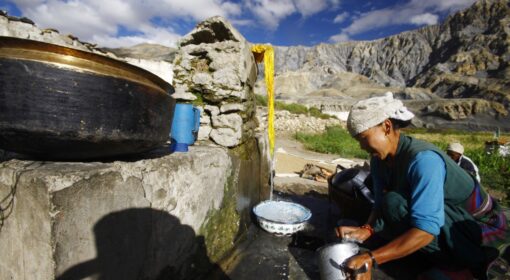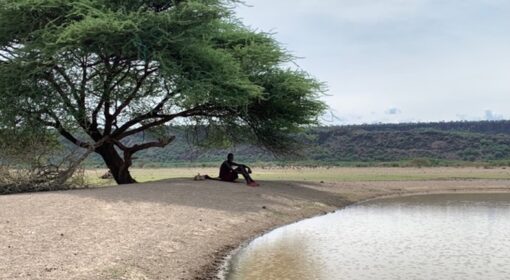posted December 16, 2012

In public imagination, cloud-seeding has only recently crossed over from the realm of science fiction to hi-tech. However, the first time a cloud was ‘seeded’ to produce snow was as long back as 1946.
The process involves introducing chemicals such as Silver Iodide or Dry Ice in clouds that contain water colder than zero degrees Celsius. These chemicals catalyze the process by which ice crystals/water droplets are formed, inducing rain/snow from those clouds.
Public perceptions and policy prescriptions paint cloud-seeding in various hues. Usually it is seen either as an ideal drought-control measure, or as an act of man taking nature in his own hands, foolhardy and bound to wreck havoc. Both views are united in seeing the technology as an immensely powerful tool.
However, talk to a scientist who has spent decades studying the technology and he’ll tell you there is little reason to either champion it or dread it: we simply don’t know if it works. The strong opinions for and against cloud-seeding are based on dubious claims made by private companies in order to sell their wares. “We should be aware of private companies that try to convince the public that they can perform miracles. But they can’t,” says Prof. Zev Levin (Tel Aviv University/ The Cyprus Institute). Following are excerpts from his recent interview with TheWaterChannel.
On corporate interest and the politics of knowledge creation:
Cloud seeding began about 60 years ago. Since then, research and implementation in the field has been dominated by private companies (and government agencies) who came in and promised increased precipitation over given areas, without backing it up with robust data from scientifically-designed experiments. Basic scientific approaches- such as seeding one area and observing another as the control- are disregarded by ‘studies’ originating from these organisations.
The situation is akin to someone developing a new medicine, and then going around claiming that it works. The claims have to be substantiated by a number of experiments and statistical analysis of results, which has not been done enough in the area of cloud seeding.
I was the President of the International Commission for Clouds and Precipitation. We just organized a conference in Leipzig, and were surprised that only a handful of the 600 papers submitted for presentation referred to cloud-seeding. On the other hand, people engaged in operational cloud seeding come up with many studies and papers, as was evident at the Weather Modification Association conference earlier in 2012. However, most of these ‘studies’ lack scientific analysis and disregard basic information such as cloud characteristics. So while such studies are many in number and claim progress in cloud-seeding technology, it is difficult to be encouraged by them!
One can see why private-sector companies engaged in cloud seeding would champion cloud-seeding. But what incentives do governments have to advocate a particular technology, as China has been?
When a country is in dire need of water and someone comes along and claims that they can increase precipitation for a small amount of money, people are inclined to believe them. Whether past results have been good or not, people/politicians think it would be worth the risk.
The Chinese are reporting cloud-seeding successes all over the place, but if you look at the data, there is no real proof. In China, cloud-seeding activities provide employment to several thousands. Any evidence that questions the success of cloud-seeding threatens these jobs. So it is a self-maintaining prophecy; they convince themselves that the technology works.
It is quite possible that they have met with success in some cases. However, there have hardly been any scientific evaluations, properly-designed experiments that conclude so. In 2008, the Chinese shot rain-dispersal rockets over Beijing to make sure it did not rain during the opening ceremony of the Olympics. (This is the opposite of ‘seeding’ clouds ‘for’ rain, but the basic technology is the same). Okay, it did not rain, but we can’t say for sure whether that had anything to do with the human intervention.
Cloud seeding is often undertaken as a drought management measure. This has been the case most recently in China, United States and India. If we get the technology right, would it be handy in managing droughts?
Where there is drought, there is usually a lack of rain clouds as well. Cloud-seeding can be done only when you have rain clouds. But if a drought-struck area does have clouds (and if it is proved that cloud-seeding does indeed work), I agree that you can add a certain amount of water to the local water bank. But we are not there yet. Very few cloud-seeding experiments have proved to be micro-physically and statistically correct.
Countries have been accused of using cloud-seeding to ‘steal rain’ from other countries…
This is unjustified, based on the belief that when you are seeding a cloud and (hopefully) producing rain at point A, you are decreasing it at point B.
This argument might have some theoretical legitimacy. In practice, however, it is irrelevant as we are talking about very, very small amounts of change in precipitation. The efficiency of a cloud producing rain is about 20-30%. So most of the water in the clouds does not come down as rain anyways. If, by cloud-seeding, you are increasing precipitation by 10%, you are increasing the efficiency of precipitation by a mere 2%. So you are milking the cloud only 2% more than what you would otherwise have.
It is feared that Cloud Seeding could be used as a weapon in conflict. In fact, the United States is known to have used it during the Vietnam War to prolong the monsoon over Laos.
Every technology can be used or misused. Once it is sufficiently established that cloud-seeding does work, it is certainly possible that it might be used as a weapon. If you see a cloud over a mountain and can get it to produce more snow, you can create an avalanche. Such possibilities can be ruled out. But at this point in time, I believe we are far from it.
What the Americans did in Laos and North Vietnam…there is no proof that they succeeded in what they tried to do.
As a precipitation control measure, what possibilities does cloud seeding present for managing water scarcity in the context of Climate Change?
Cloud-seeding as a method is relatively small-scale and is not going to affect anything related to the climate at a global scale. What it can do—if it is established that it works perfectly—is bring about local/regional level changes in water availability. It can certainly be supplemental to other forms of adaptation to climate change/ variability, especially because you can drink this water that would come down from the clouds.
As a technology of ‘producing’ potable water, cloud-seeding is cheaper than desalination. But cloud-seeding works when you already have rain clouds, whereas desalination can be carried out all the time. So as a strategy for securing water supply, I would rather put my money into desalination than cloud seeding.
A less-known discussion is one on the use of cloud-seeding as measure of mitigating Climate Change. This pertains to geo-engineering. Since governments around the world are not as committed to reducing emissions as required, it is useful to think in terms of reducing the total radiation reaching the earth’s surface. The idea is to produce an effect that opposes to the green house effect.
This can be tried in many ways. For example, one suggestion is spraying sea salt above a certain height over the oceans. This would produce more clouds that would reflect a greater part of the solar radiation back into space. (This method is often criticized for interfering too much with nature and its potential unknown effects on regional climate) This would be an example of the application of cloud-seeding not related to rains/ precipitation.
Dr. Zev Levin is Professor Emeritus at the Department of Geophysical, Atmospheric and Planetary Sciences, and Professor at The Cyprus Institute. Among his notable recent publications on Cloud-Seeding are ‘On the State of Cloud Seeding for Rain Enhancement’ and ‘Lessons Learned from 50 years of Cloud-Seeding in Israel.’
{jcomments on}



